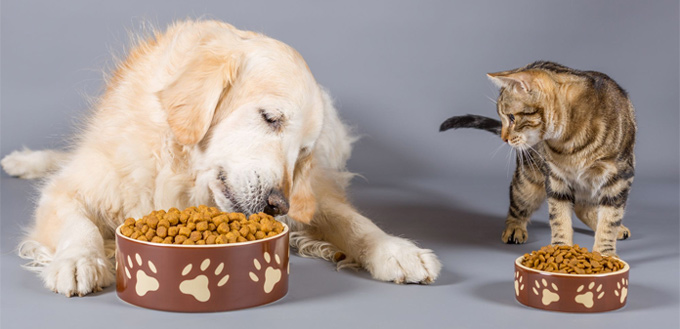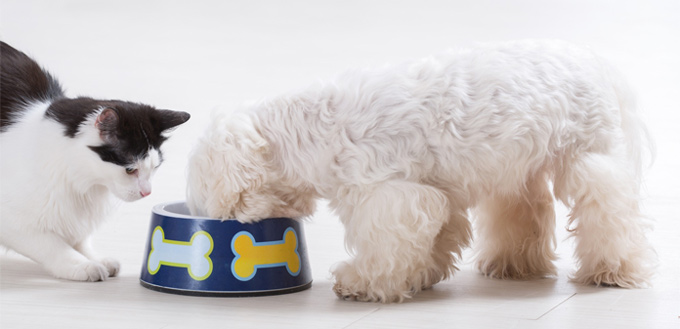If you have had the opportunity to observe a number of canines, what you are bound to realize about them sooner than later is that they love eating cat food. Funny isn’t it?
Dietary requirements of cats and dogs are different. Cats are innately carnivorous, meaning meat is a mandatory part of their diet. It is a biological necessity. While cats cannot thrive without meat, dogs as many believe are omnivores. Canines need wider variety in their diet to meet their nutritional requirement as compared to felines.

That being said, some dogs are so fond of cat food that they do not mind eating cat food in discarded form that has been totally digested and deposited in the kitty’s litter box. Keeping aside yuck factor, to many dogs, kitty’s tootsies rolls are a pure delicacy.
Why Does Your Dog Eat Cat Food?
You might as well accept the fact that cat food in any form would truly appeal to your dog. But why is your dog so keen on eating feline food? Both dog and cat food looks the same. They are dry kibble that smell the same and come in strikingly similar shapes and sizes. The packaging is also more or less similar.
Then what is the difference? Comparatively cat’s food is very rich in protein, owing to a higher percentage of meat. As both the meaty flavour and smell is stronger than dog food, canines are easily drawn towards feline food.
Can Your Dog Eat Cat Food?
The answer is no – at least not on a regular basis. However, at times cat food could be used as a motivator for dogs. Many dog owners use cat food as a treat for their pets. But it is important to bear in mind that unless your vet advises, the best food for your canine is dog food.
Dogs have the ability to digest carbohydrate-based food and can thrive on a plant-based diet, unlike cats. Unlike cats, dogs also do not depend on meat-specific protein diet. A recent study has also shown dogs as being capable of digesting a starch-rich diet as a part of domestication.
Related Post: Best Dog Treats
Side Effects of Eating Cat Food
Cat food is bereft of several vitamins and minerals that are necessary for your canine to enjoy good health. As a result, if you feed cat food to your pet on a regular basis, there is a chance that vitamin and mineral deficiency might crop up.
Feline food is also short on zinc and vitamin E, both of which are a must for dogs. It also contains an ingredient called taurine which dogs do not need in their diet as their bodies are designed to generate taurine. Over a period of time, this nutrient imbalance could lead to gastrointestinal disorders and obesity. Dogs need a proper balance between fat, fibre and protein which is ensured by a dog’s diet that contains 18-22% protein as against a cat’s diet of 26-30% protein.
As per studies, the minimum requirement of fat for dogs is 5% and 9% for cats, which implies that cat’s food would be high on fat content. Therefore, a dog feeding on cat food often tends to gain weight. Cat food also has an adverse impact on the dog’s liver and kidneys owing to the protein content being higher than what the dog requires.
For a dog, the worst consequence of eating cat food is pancreatitis, meaning painful inflammation of the pancreas. If left untreated, it could be life-threatening too. There are certain symptoms of pancreatitis that become evident, like hunched back, distended abdomen, loss of appetite, weakness, lethargy and fever. Vomiting and diarrhoea are the most common side effects of cat food and they impact the dog’s metabolism and endanger its life.
You May Also Like: Best Dog Food Brands
Dog’s Diet Requirement as Against a Cat’s Diet
Amino acids are the building blocks of protein and they are classified into two groups, namely essential and non-essential. Dogs and cats are both capable of producing non- essential amino acids. Essential amino acids are obtained from their diet.
Both cats and dogs require twenty-two amino acids to enjoy good health. Out of these, dogs are capable of generating twelve amino acids on their own and cats can produce eleven. The rest are provided through their diet. Cats require two essential fatty acids, Linoleic and arachidonic, for kidney health, healthy skin and coat, and reproduction health. In comparison, dogs require only Linoleic acid.
Dogs also require lesser amount of folic acid, thiamine, niacin, vitamins A and B as compared to cats.

Final Words
Cats and dogs differ in their nutritional requirement. Therefore, feeding cat food to your canine is a definite no-no if your canine is to enjoy good health. However, a dog’s craving for cat food cannot be overlooked. Occasional consumption of cat food will serve to satiate the taste buds of your canine and hence can be used as a treat.
Related Post: Best Dry Cat Food






